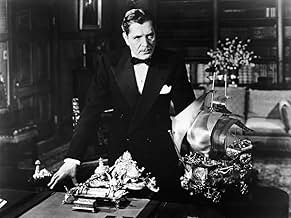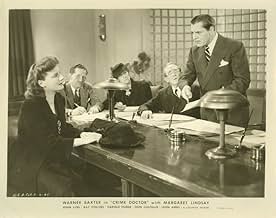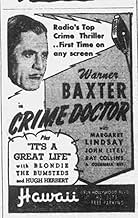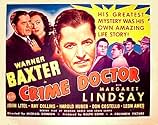Ajouter une intrigue dans votre langueAmnesia victim, Robert Ordway, becomes the country's leading criminal psychologist. After he is hit on the head by someone from his past, he suddenly remembers his previous life as a crimina... Tout lireAmnesia victim, Robert Ordway, becomes the country's leading criminal psychologist. After he is hit on the head by someone from his past, he suddenly remembers his previous life as a criminal.Amnesia victim, Robert Ordway, becomes the country's leading criminal psychologist. After he is hit on the head by someone from his past, he suddenly remembers his previous life as a criminal.
Phil Arnold
- Third Reporter in Court
- (uncredited)
Paul Bryar
- First Reporter in Court
- (uncredited)
Wallis Clark
- Judge
- (uncredited)
Chester Clute
- Headwaiter
- (uncredited)
Kernan Cripps
- Turnkey
- (uncredited)
Harold De Becker
- Bartender
- (uncredited)
Franklyn Farnum
- Juror
- (uncredited)
Avis en vedette
With the exception of the Rathbone and Bruce Sherlock Holmes series, this is quite possibly the best of the 'mystery' series of the 30s and 40s. The series begins with this movie as Phil Morgan, master criminal, is double crossed by his gang, beaten and dumped along a roadside. As a result, he suffers from amnesia. This movie, the first of the series, establishes The Crime Doctor's background, explains how and why he became a doctor (a psychiatrist, actually), head of the parole board and helped many convicts find the 'straight and narrow'.
The element that makes this movie and the series in general unique is that it relies on psychiatry and the tendencies of the mentally ill. They often tease you by inserting an obviously unbalanced person and although the plot may lead one to believe that person is the "perp" they may or may not be the actual "perp". Because psychiatry was relatively new and often misunderstood, it provided general insight to the subject. In many ways, the series has yet to become dated although the psychological concepts may appear to be fairly basic nowadays.
A series of factors make this movie series much more enjoyable than others such as The Lone Wolf, Boston Blackie or Bulldog Drummond. The first is the consistency. The quality of the stories in all ten movies remains high throughout the series where the stories of other series tend to deteriorate into standard potboilers after the studio has captured the audience's interest. Second, the same actor plays the lead character in all of the movies. Third, the quality of the supporting cast is exceptional throughout the series. Some of the more recognizable supporting cast includes John Litel, Ray Collins, Harold Huber, Barton MacLane, Jerome Cowan, Reginald Denny, Eduardo Ciannelli, Nina Foch, George Zucco, Ben Weldon, Hillary Brooke, William Frawley, Ellen Drew and last, but far from least, a very young Lois Maxwell who played Miss Moneypenny in at least 15 James Bond films.
However, over the six years the series was shot, one can easily see Baxter's health deteriorating.
The element that makes this movie and the series in general unique is that it relies on psychiatry and the tendencies of the mentally ill. They often tease you by inserting an obviously unbalanced person and although the plot may lead one to believe that person is the "perp" they may or may not be the actual "perp". Because psychiatry was relatively new and often misunderstood, it provided general insight to the subject. In many ways, the series has yet to become dated although the psychological concepts may appear to be fairly basic nowadays.
A series of factors make this movie series much more enjoyable than others such as The Lone Wolf, Boston Blackie or Bulldog Drummond. The first is the consistency. The quality of the stories in all ten movies remains high throughout the series where the stories of other series tend to deteriorate into standard potboilers after the studio has captured the audience's interest. Second, the same actor plays the lead character in all of the movies. Third, the quality of the supporting cast is exceptional throughout the series. Some of the more recognizable supporting cast includes John Litel, Ray Collins, Harold Huber, Barton MacLane, Jerome Cowan, Reginald Denny, Eduardo Ciannelli, Nina Foch, George Zucco, Ben Weldon, Hillary Brooke, William Frawley, Ellen Drew and last, but far from least, a very young Lois Maxwell who played Miss Moneypenny in at least 15 James Bond films.
However, over the six years the series was shot, one can easily see Baxter's health deteriorating.
This film is much better than what one might expect, given the studio that made it and the other films of this type put out at the time. Warner Baxter was a good actor, the supporting cast is able, and the writing is taut, uncomplicated and well-done. Direction, lighting and photography are professional. In short, there are few, if any, faults, and the film is well worth a watch. Leon Ames makes an early appearance in a somewhat far fetched sequence involving the rehabilitation of a hardened, bitter convict, but this is a minor, minor flaw in an otherwise very well constructed film. As another reviewer wrote, there are, thankfully, no dumb cops or simple minded assistants, just a well thought out plot and good acting.
... as well as the Great Depression as a two front war with everything at stake yields bigger fish to fry. This is what this first film in the Crime Doctor crime/mystery series represents in the person of Dr. Robert Ordway (Warner Baxter).
The movie opens with a car speeding along the road with a sign referring to the presidential campaign of 1932. The car slows down and an unconscious man is dumped from the vehicle that then speeds off again. Next we see the man without an identity recovering in the hospital with no memory of who he was before. The nurses dub the mystery man Robert Ordway after the wing of the hospital in which he is staying. Kindly Dr. John Carey (Ray Collins) works with Ordway after he is discharged to help him recover his memory, but no association -not even going through the phone book name by name - yields results. A check of his fingerprints with police records also turns up nothing. Of course, all that proves is that Ordway was clever enough to never be arrested, not that he wasn't a criminal. With all of the time he's spent with the good doctor, Ordway has developed an interest in medicine, and with he and Dr. Carey agreeing that the unmasking of his identity is something that he should no longer hope to have solved in the near future, he decides to study medicine himself and specialize in psychiatry.
So Ordway starts out as a freshman in college in his early 30's, with his studies requiring the next ten years of his life. The world changes a great deal in the next ten years - Prohibition ends, the Depression eases, and World War II begins. In all this time Ordway is no closer to recovering his identity. As he begins to practice medicine, he spends a great deal of time working with convicts at the prison. He's drawn here because he wants to do some good but also because he hopes that someone there will recognize him and help him reclaim his memory. In the back of his mind he's got to know that nobody gets dumped as he did from a speeding automobile in 1932 without the high probability that he was somehow mixed up in crime.
There's a complicating factor too. Ordway has become involved with an attractive young woman who works with female ex-cons - Grace Fielding (Margaret Lindsay). At this point, Ordway doesn't even know if he has a wife out there somewhere, so he can't make plans with Grace until he knows his true marital status. How will all of this work out? Watch and find out.
This first in the series was probably never intended to be anything other than just one film, so this movie wraps up in a self-contained kind of way that will leave you wondering what ever happened to this or that character if you watch the whole series. It was a big hit, so Columbia released a whole series featuring the Dr. Robert Ordway character, always starring Warner Baxter, over the next seven years. The rest of the series focuses not so much on Ordway's life as it does on some mystery Ordway has wandered into and how he solves it, but in this first film the mystery is Ordway himself. Who is he really? And if he recovers his memory and the news is bad - will remembering alone make him a criminal all over again? Does a man need a clean slate of a mind to really have a clean slate? Interesting material done in the quick spartan way required by poverty row Columbia's budget, but done well all the same.
The movie opens with a car speeding along the road with a sign referring to the presidential campaign of 1932. The car slows down and an unconscious man is dumped from the vehicle that then speeds off again. Next we see the man without an identity recovering in the hospital with no memory of who he was before. The nurses dub the mystery man Robert Ordway after the wing of the hospital in which he is staying. Kindly Dr. John Carey (Ray Collins) works with Ordway after he is discharged to help him recover his memory, but no association -not even going through the phone book name by name - yields results. A check of his fingerprints with police records also turns up nothing. Of course, all that proves is that Ordway was clever enough to never be arrested, not that he wasn't a criminal. With all of the time he's spent with the good doctor, Ordway has developed an interest in medicine, and with he and Dr. Carey agreeing that the unmasking of his identity is something that he should no longer hope to have solved in the near future, he decides to study medicine himself and specialize in psychiatry.
So Ordway starts out as a freshman in college in his early 30's, with his studies requiring the next ten years of his life. The world changes a great deal in the next ten years - Prohibition ends, the Depression eases, and World War II begins. In all this time Ordway is no closer to recovering his identity. As he begins to practice medicine, he spends a great deal of time working with convicts at the prison. He's drawn here because he wants to do some good but also because he hopes that someone there will recognize him and help him reclaim his memory. In the back of his mind he's got to know that nobody gets dumped as he did from a speeding automobile in 1932 without the high probability that he was somehow mixed up in crime.
There's a complicating factor too. Ordway has become involved with an attractive young woman who works with female ex-cons - Grace Fielding (Margaret Lindsay). At this point, Ordway doesn't even know if he has a wife out there somewhere, so he can't make plans with Grace until he knows his true marital status. How will all of this work out? Watch and find out.
This first in the series was probably never intended to be anything other than just one film, so this movie wraps up in a self-contained kind of way that will leave you wondering what ever happened to this or that character if you watch the whole series. It was a big hit, so Columbia released a whole series featuring the Dr. Robert Ordway character, always starring Warner Baxter, over the next seven years. The rest of the series focuses not so much on Ordway's life as it does on some mystery Ordway has wandered into and how he solves it, but in this first film the mystery is Ordway himself. Who is he really? And if he recovers his memory and the news is bad - will remembering alone make him a criminal all over again? Does a man need a clean slate of a mind to really have a clean slate? Interesting material done in the quick spartan way required by poverty row Columbia's budget, but done well all the same.
I hope that TCM broadcasts more of the "Crime Doctor" series, based on the radio show. Starring Warner Baxter, 1943's "Crime Doctor" is one of the first films Michael Gordon (Pillow Talk) directed, and it's a good, solid B movie.
Baxter plays a criminal named Phil Morgan who gets amnesia after being left for dead on the side of a road. He rehabilitates himself and, still not knowing who he is, becomes a noted psychiatrist named Robert Ordway who works with prisoners as well as other patients.
However, Phil Morgan stole and hid $200,000 and his fellow gang members want the money. As word gets around that Dr. Ordway is Phil Morgan, the question is - does he really not remember, or does he know who he is and where he put the money?
Baxter was 54 years old when this film was made. Fifty-four in 1943 isn't what it is today, so when the character announces that "thirty years of his life" have been wiped out, one wonders which thirty years he's talking about.
The film covers a span of ten years, but it's just as hard to buy he's forty. It's a minor point - Baxter gives a sincere performance with an undertone of real gentleness.
The supporting cast includes the lovely Margaret Lindsay, John Litel (who play Nancy Drew's father in the series), Perry Mason's Ray Collins, and Leon Ames.
Baxter plays a criminal named Phil Morgan who gets amnesia after being left for dead on the side of a road. He rehabilitates himself and, still not knowing who he is, becomes a noted psychiatrist named Robert Ordway who works with prisoners as well as other patients.
However, Phil Morgan stole and hid $200,000 and his fellow gang members want the money. As word gets around that Dr. Ordway is Phil Morgan, the question is - does he really not remember, or does he know who he is and where he put the money?
Baxter was 54 years old when this film was made. Fifty-four in 1943 isn't what it is today, so when the character announces that "thirty years of his life" have been wiped out, one wonders which thirty years he's talking about.
The film covers a span of ten years, but it's just as hard to buy he's forty. It's a minor point - Baxter gives a sincere performance with an undertone of real gentleness.
The supporting cast includes the lovely Margaret Lindsay, John Litel (who play Nancy Drew's father in the series), Perry Mason's Ray Collins, and Leon Ames.
It's odd that CRIME DOCTOR ('43), the film that started the B-film series at Columbia, is one of the least involving of the Dr. Ordway stories. The first half-hour is pretty dull before the film takes on any real interest in the amnesia background of Baxter's character.
His development from complete amnesia to gradual recall is well handled and some of the scenes with JOHN LITEL have a certain amount of interest, but the story lacks overall believability with RAY COLLINS turning to the phone book in a search for Baxter's name and then becoming his mentor and leading him into a doctor's career with a quick montage of events establishing Baxter as a psychiatrist.
MARGARET LINDSAY is attractive as the female interest, looking so much like a prettier version of Barbara Stanwyck, whom I always thought she resembled in manner and looks. For fans of the series, this one will do, but surprisingly it's not the sort of "first film in the series" that I expected and you have to wonder why Columbia decided to make a series after this one.
WARNER BAXTER looks quite ill in most of his close-ups, so you can see the man was in fragile health all during these "Crime Doctor" films. He gives his usual solid performance but the film was a disappointment for me.
His development from complete amnesia to gradual recall is well handled and some of the scenes with JOHN LITEL have a certain amount of interest, but the story lacks overall believability with RAY COLLINS turning to the phone book in a search for Baxter's name and then becoming his mentor and leading him into a doctor's career with a quick montage of events establishing Baxter as a psychiatrist.
MARGARET LINDSAY is attractive as the female interest, looking so much like a prettier version of Barbara Stanwyck, whom I always thought she resembled in manner and looks. For fans of the series, this one will do, but surprisingly it's not the sort of "first film in the series" that I expected and you have to wonder why Columbia decided to make a series after this one.
WARNER BAXTER looks quite ill in most of his close-ups, so you can see the man was in fragile health all during these "Crime Doctor" films. He gives his usual solid performance but the film was a disappointment for me.
Le saviez-vous
- AnecdotesRay Collins, who plays Dr. Carey in this film, is one of several actors who played the title character in the "Crime Doctor" radio series.
- ConnexionsFollowed by Crime Doctor's Strangest Case (1943)
Meilleurs choix
Connectez-vous pour évaluer et surveiller les recommandations personnalisées
Détails
- Date de sortie
- Pays d’origine
- Langue
- Aussi connu sous le nom de
- Karanlık mazi
- Lieux de tournage
- Mulholland Drive, Hollywood Hills, Los Angeles, Californie, États-Unis(Establishing shot.)
- société de production
- Consultez plus de crédits d'entreprise sur IMDbPro
- Durée1 heure 6 minutes
- Couleur
- Rapport de forme
- 1.37 : 1
Contribuer à cette page
Suggérer une modification ou ajouter du contenu manquant

Lacune principale
By what name was Crime Doctor (1943) officially released in Canada in English?
Répondre

































